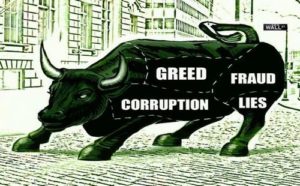Carmine Di Sibio, the international chairman of EY, said in a letter to clients published earlier thsi month that while he “regrets” the firm’s staggering lapse in supervising Wirecard (something the firm has continued to blame entirely on Wirecard’s deceptions, along with the invisible hand of Russian intelligence), the incident was a lesson learned, though he insisted that EY was ultimately “successful” in detecting the fraud.
While that’s technically true, it’s also true that dozens of red flags surfaced over the years that seemed to openly hint at the ongoing massive fraud operating just below the surface. And as auditors, regulators and prosecutors sift through the wreckage, they’re uncovering more stunning details prompting them to ask themselves: How did Wirecard’s shell game continue for so long without anybody speaking up?

The Financial Times, a paper that put its reputation on the line to back its reporting on Wirecard, and was ultimately vindicated after facing startling pushback from Wall Street analysts, Wirecard and German regulators, obtained a copy of an early report from Wirecard’s administrator. As bankruptcy courts pick through the wreckage, the report reveals that the fraud at Wirecard ran much deeper than the Southeast Asia business that was previously reported as the locus of the fraud.
In reality, Wirecard had only a few profitable business lines. And the stupefying staff and operational bloat that the company carried is almost shocking. Just imagine: Thousands of employees, shuffling paper, performing “busywork” with no real purpose like a nightmarish, real-life take on “Office Space”.
The €1.9 billion in fraudulent profits Wirecard reported between the beginning of 2015 and Q1 2020 was actually a €740 million ($860) loss. Even if the fraud hadn’t been uncovered when it did – even if the FT had never printed a word – the company would have eventually dissolved, as the burn rate far outstripped any reasonable expectation of income or capital raised.
Furthermore, bankruptcy court has determined that the real value of Wirecard’s assets is just €428 million, an amount dwarfed by the €3.2 billion in debt Wirecard carried when it collapsed.
Wirecard’s fabricated Asian business was not its only deception. The rest of the once-lauded German payment provider’s business was chaotic, beset by byzantine reporting lines, hobbled by lamentable IT and racking up losses, according to a report by Wirecard’s administrator and accounts of former employees. The picture that emerges of the Wirecard businesses that did exist is a stark contrast to the one painted by former chief executive Markus Braun, who hailed the group as a highly profitable pioneer in the payments industry. It reveals the scale on which the company, Germany’s biggest corporate fraud in decades, also misled investors about its real businesses. “Only a few units of the group were actually involved in conducting operative business that was customer-facing and generated revenue,” the administrator Michael Jaffé wrote in his report, a copy of which was seen by the Financial Times.
So, what did Wirecard spend all this money on? Well, certainly not IT. The report cited by the FT shows that Wirecard’s businesses ran on a hodgepodge of IT systems that were virtually unworkable. Any IT auditor would have noted significant issues, they said.
Its computer systems were inherited from companies acquired over the years and never fully integrated. Wirecard Bank, for instance, is still running on software originally developed for Germany’s small co-operative banks and which will be switched off by its IT service provider by the end of this year, according to people familiar with the matter. “If IT auditors had been professional and serious, huge risks, weaknesses and non-compliance issues would have emerged a long time ago,” according to a former Wirecard IT employee, who was scathing about the “unbelievable brittleness of [Wirecard’s] IT infrastructure”.
Even up until its final months before diving into bankruptcy, Wirecard continued to expand its head count. All told, the company had more than 6,000 employees around the world. But only a fraction of them were needed to run the business.
Even as Wirecard faced increasing scrutiny of its accounting, the group’s headcount continued to rise, climbing by a quarter from early last year to 6,300 at the time of its implosion. Over the same period, its real revenues grew at less than half that rate, according to the administrator. The report points to bloated costs and a colossal amount of corporate waste. “Employees never faced the necessity to reduce the services they were using to those that were really needed as cash was abundantly available in the past,” it noted, adding that the company was suffering from “excessive overhead and personnel capacities”. “Only a fraction” of the employees were actually required to run Wirecard’s non-fraudulent business, the report found.
With this rate of burn, the company would have needed to raise money by the end of the year, or face insolvency.
By the time it unravelled in late June, the total was €10m a week and the company’s own internal planning predicted that figure would rise to more than €15m — some €200m for the third quarter as a whole, according to the administrator’s report. At that rate, Wirecard would have needed to raise fresh cash by the end of this year to pay its bills.
Wirecard’s “totally opaque” structure and “small business mentality” meant that its 55 subsidiaries were all effectively siloed off from one another. The main office in Munich had no idea what was going on elsewhere. in retrospect, it’s a setup seemingly designed to enable an ongoing fraud.
If extravagant spending is one of Mr Jaffé’s findings, another is what the report describes as Wirecard’s “totally opaque” and inefficient structure, consisting of at least 55 subsidiaries scattered over four continents. Staff at its headquarters on the outskirts of Munich did not know what the group’s different units were doing, the administrator concluded, with neither their tasks and responsibilities — or the payments and loans between the divisions — properly recorded. There was “a small business mentality” at many of its units, former employees told the FT, describing businesses that Wirecard had hoovered up around the world and largely left to their own devices.
Receive a daily recap featuring a curated list of must-read stories.
At times, this led to “bizarre outcomes”, like employees in the antipodes performing work for distant offices in Europe.
The internal chaos led to bizarre outcomes. A team of IT specialists, working in Athens, but part of a subsidiary with headquarters in New Zealand, provided services to Wirecard’s German HQ that were not needed, the administrator found. In another example, when the administrator asked managers at a different Asian-based subsidiary about how they contributed to the group, the reply was “we don’t really know”, according to a person briefed on the matter.
The FT concluded its report with a comment from a German finance professor who argued that the fraud should have been caught earlier, and the fact that any “Big 4” firm would miss such conspicuous red flags is too difficult to believe. Perhaps a blind eye was turned. Or maybe auditors really were blinded by ex-CEO Markus Baram’s marketing prowess, that they simply didn’t question it when the company launched into technical explanations of its – totally fictitious – business. Source: zerohedge
StevieRay Hansen
Editor, BankstersCrime
God often uses men who are not of the best moral character. Pharaoh, Nebuchadnezzar, Cyrus, Herod, and Trump (amongst others), to accomplish His will in events He orchestrates during human history. We either trust the sovereignty of God or we don’t. Nothing happens apart from Him…
The best index to a person’s character is how he treats people who can’t do him any good, and how he treats people who can’t fight back…
The Birth Pains Are Growing Stronger….
One of the signs of ruling class collapse is when they can no longer enforce the rules that maintain them as a ruling class. When the Romans started making exceptions to republican governance, it was a matter of time before someone simply decided the rules no longer applied to them. Perhaps the robot historians will consider Obama our Marius or Sulla. Maybe that person is in the near future. Either way, the rule of law is over and what comes next is the rule of men.
“Don’t piss down my back and tell me it’s raining.” Outlaw Josey Wales
WE NOW LIVE IN A WORLD THAT IS PURE FABRICATION

![]()




